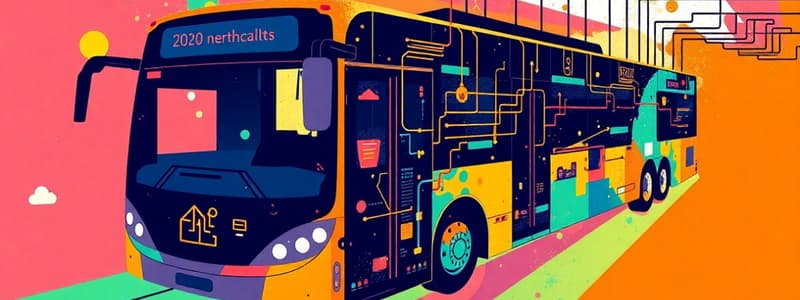Podcast
Questions and Answers
What defines a Hybrid topology?
What defines a Hybrid topology?
- A combination of similar topologies connected together.
- The connection of various different topologies. (correct)
- A single type of topology connecting all nodes.
- A network solely based on wireless devices.
Which of the following is NOT an advantage of Hybrid topology?
Which of the following is NOT an advantage of Hybrid topology?
- Scalability with addition of devices.
- Flexibility in network design.
- Reliable operation during faults.
- Easy design process. (correct)
What is a major disadvantage of Hybrid topology?
What is a major disadvantage of Hybrid topology?
- Low reliability under faults.
- High cost of infrastructure. (correct)
- Limited expansion capabilities.
- Minimal flexibility for custom designs.
How does Hybrid topology handle faults within the network?
How does Hybrid topology handle faults within the network?
Which of the following statements about types of computer networks is incorrect?
Which of the following statements about types of computer networks is incorrect?
What is the primary advantage of using a bus topology?
What is the primary advantage of using a bus topology?
What type of cable is primarily used in bus topology networks?
What type of cable is primarily used in bus topology networks?
What happens if two nodes send messages simultaneously in a bus topology?
What happens if two nodes send messages simultaneously in a bus topology?
Which of the following is a disadvantage of bus topology?
Which of the following is a disadvantage of bus topology?
How is ring topology different from bus topology?
How is ring topology different from bus topology?
What is a significant challenge when troubleshooting a bus topology?
What is a significant challenge when troubleshooting a bus topology?
Which statement about adding new devices to a bus topology is true?
Which statement about adding new devices to a bus topology is true?
What does attenuation refer to in the context of bus topology?
What does attenuation refer to in the context of bus topology?
What was the main purpose of ARPANET?
What was the main purpose of ARPANET?
When did the World Wide Web open to the public?
When did the World Wide Web open to the public?
What is the term for the smaller pieces into which information is broken for transmission on the internet?
What is the term for the smaller pieces into which information is broken for transmission on the internet?
What role does a router play in the Packet Routing Network?
What role does a router play in the Packet Routing Network?
Which protocol ensures that no packet is lost during data transmission?
Which protocol ensures that no packet is lost during data transmission?
Who is credited as the 'Father of the Internet' for his role in the development of the World Wide Web?
Who is credited as the 'Father of the Internet' for his role in the development of the World Wide Web?
What is HTML primarily used for?
What is HTML primarily used for?
What is the significance of URLs in web browsing?
What is the significance of URLs in web browsing?
What is the primary responsibility of the Network Layer?
What is the primary responsibility of the Network Layer?
Which protocol is considered a reliable transport protocol?
Which protocol is considered a reliable transport protocol?
What process involves converting data into smaller units known as segments at the Transport Layer?
What process involves converting data into smaller units known as segments at the Transport Layer?
Which of the following is a characteristic of User Datagram Protocol (UDP)?
Which of the following is a characteristic of User Datagram Protocol (UDP)?
What is the main function of routing within the Network Layer?
What is the main function of routing within the Network Layer?
What does the Network Layer add to the header of the frame?
What does the Network Layer add to the header of the frame?
Which layer of the OSI model is responsible for ensuring that messages are transmitted in order?
Which layer of the OSI model is responsible for ensuring that messages are transmitted in order?
Which of the following best describes internetworking in the context of the Network Layer?
Which of the following best describes internetworking in the context of the Network Layer?
What is the primary characteristic of a port in a communication node?
What is the primary characteristic of a port in a communication node?
Which type of twisted pair cable is primarily used for high-speed data communication?
Which type of twisted pair cable is primarily used for high-speed data communication?
What is the primary advantage of using unshielded twisted pair cables?
What is the primary advantage of using unshielded twisted pair cables?
Which of the following is NOT a characteristic of the shielded twisted pair cable?
Which of the following is NOT a characteristic of the shielded twisted pair cable?
What is a disadvantage of using unshielded twisted pair cables?
What is a disadvantage of using unshielded twisted pair cables?
What does the term 'guided media' refer to in data transmission?
What does the term 'guided media' refer to in data transmission?
Which type of address is associated with sending emails?
Which type of address is associated with sending emails?
What is the frequency range for twisted pair cables?
What is the frequency range for twisted pair cables?
Flashcards are hidden until you start studying
Study Notes
Topology of a Network
-
Topology defines the structure of a network, showcasing how components are interconnected.
-
Types of Topology
- Physical topology: Represents the physical arrangement of network devices.
- Logical topology: Represents the flow of data within the network.
Bus Topology
-
Description: All devices are connected to a single cable, called the backbone cable.
-
Connection: Devices connect with drop cables to the backbone cable.
-
Data Transmission: Messages are broadcasted on the backbone cable, received by all devices.
-
Standards: Mainly used in 802.3 (Ethernet) and 802.4 standard networks.
-
Advantages:
- Cost-effective cabling.
- Moderate data speeds (up to 10 Mbps).
- Familiar technology for installation and troubleshooting.
- Device failure does not affect other devices.
-
Disadvantages:
- Extensive cabling requirements.
- Difficult to troubleshoot cable faults.
- Signal interference caused by simultaneous transmissions.
- Slows down network performance when adding new devices.
- Attenuation (signal loss) requires repeaters to regenerate the signal.
Ring Topology
- Description: Similar to bus topology but with connected ends.
Hybrid Topology
-
Description: Combines different types of topologies for data transfer.
-
Example: Combining a ring topology in one part of a bank and a bus topology in another.
-
Advantages:
- Reliable: Fault in one part does not affect the entire network.
- Scalable: Can easily expand the network size.
- Flexible: Adaptable to various organizational needs.
- Effective: Can maximize strengths and minimize weaknesses of different topologies.
-
Disadvantages:
- Complex network design.
- Expensive hub requirements.
- High infrastructure costs due to cabling and devices.
Types of Computer Networks
- Wired Networks: Use physical connections (cables) to connect devices.
- Wireless Networks: Use radio waves for communication between devices without cables.
The Internet
-
Origins:
- ARPANET (Advanced Research Projects Agency Network) was initially designed to provide a communication network that could survive a nuclear attack.
- The first public launch of the World Wide Web occurred on August 6, 1991.
-
Client and Server Interaction:
- Clients (user devices) connect to the internet through an Internet Service Provider (ISP).
- When a client requests a webpage, it connects to the server hosting the webpage.
-
Packet Transmission:
- Information is broken into packets for efficient transmission.
- Each packet contains an address to guide it to the receiving device.
- Routers, part of the Packet Routing Network, handle packet forwarding based on addresses.
-
Transfer Control Protocol (TCP):
- Responsible for ensuring reliable delivery of packets.
- Packets are reassembled at the receiver in the correct order.
-
Steps in Message Transmission:
- Computer 1 sends a message to Computer 2.
- The message is split into packets.
- TCP ensures packet delivery and quality.
- Packets reach Computer 2 and are reassembled.
Father of the Internet: Tim Berners-Lee
- Key Roles: Developed the World Wide Web, HTTP, HTML, and URLs.
- Background : Graduated with a Physics degree from Oxford University in 1976.
- Current Role: Director of the World Wide Web Consortium (W3C).
Network Layers
Data Link Layer
- Responsibilities: Packet routing and forwarding.
Network Layer
-
Devices: Routers (layer 3 devices) provide routing services.
-
Protocols: Network layer protocols, such as IP and IPv6, handle network traffic routing.
-
Functions:
- Internetworking: Establishing logical connections between devices.
- Addressing: Assigning source and destination addresses to packets.
- Routing: Determining the optimal path for data flow.
- Packetizing: Converting data into packets.
Transport Layer
-
Responsibilities:
- Ensuring message order and preventing duplication of data.
- Reliable transfer of data.
-
Segmenting: Receives data from upper layers and divides it into segments.
-
End-to-End Connection: Provides a point-to-point connection between communicating devices.
-
Protocols:
-
Transmission Control Protocol (TCP): Reliable connection-oriented protocol for transferring data over the internet.
- Establishes and maintains connections, divides data into segments, and reorders received packets.
-
User Datagram Protocol (UDP): Unreliable connectionless protocol.
- It does not require acknowledgements from the receiver, and data delivery is not guaranteed.
-
-
Port Numbers:
- Each process on a node has a unique port number for identification.
- Ports are similar to extensions of IP addresses.
-
Specific Addresses:
- User-friendly addresses exist for specific applications, such as email addresses and URLs.
Transmission Media
-
Guided Media: Physical media used for signal transmission.
-
Twisted Pair: A pair of insulated copper wires twisted together to reduce noise interference.
- Types:
- Unshielded Twisted Pair (UTP): Widely used in telecommunications.
- Shielded Twisted Pair (STP): Contains a mesh surrounding the wires for higher transmission rates.
- Types:
-
Advantages of Twisted Pair:
- Cost-effective.
- Easy to install.
- Suitable for high-speed LANs.
-
Disadvantages of Twisted Pair:
- Limited distance due to signal attenuation.
Studying That Suits You
Use AI to generate personalized quizzes and flashcards to suit your learning preferences.





